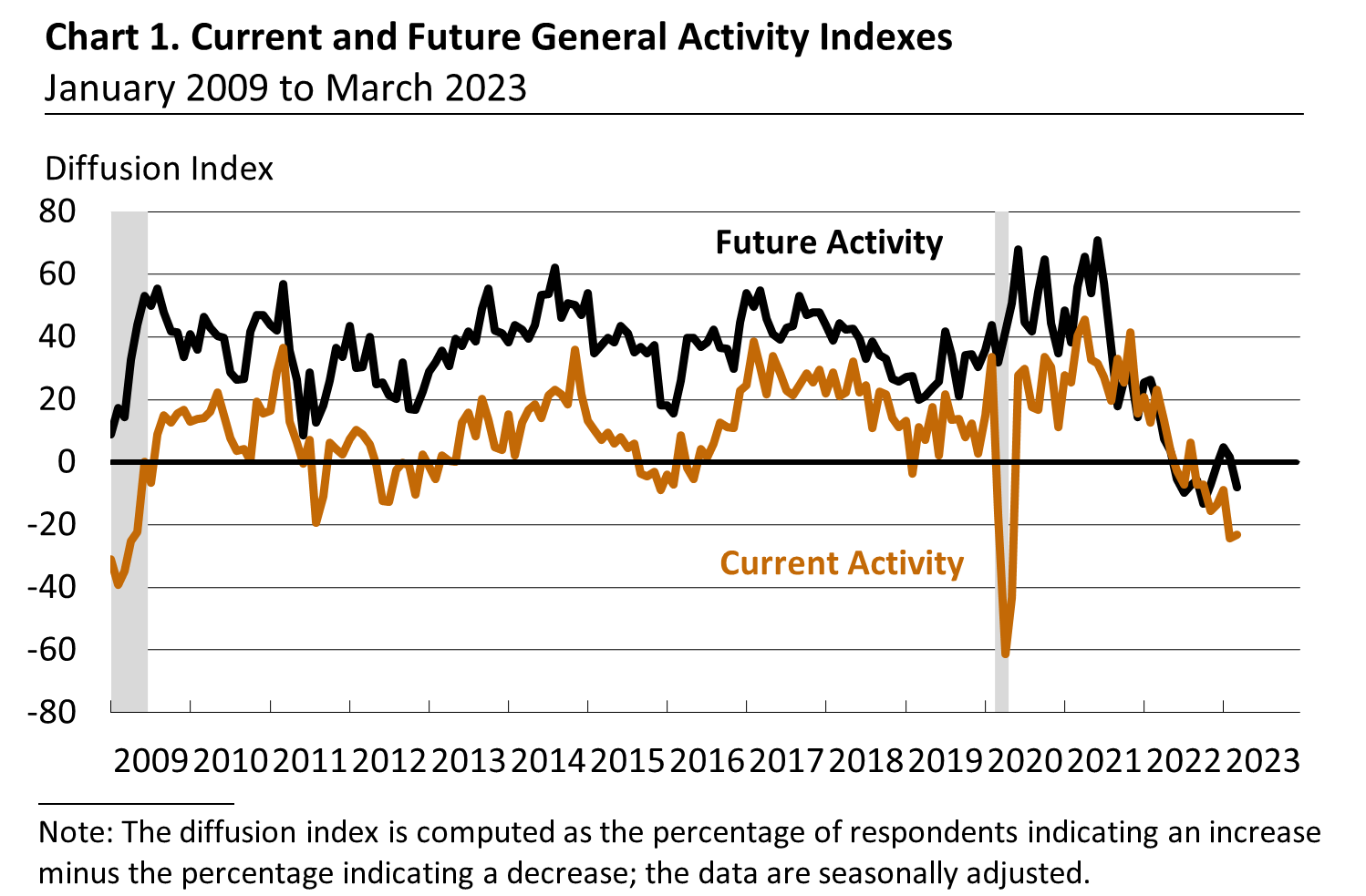March 20, 2023
March 2023 Manufacturing Business Outlook Survey
Manufacturing activity in the region continued to decline overall, according to the firms responding to March’s Manufacturing Business Outlook Survey. The survey’s broad indicators for current activity were all negative. On balance, the firms also reported a decline in employment. Most future indicators weakened, suggesting that the firms continue to have tempered expectations for growth over the next six months.
Current Indicators Weaken
The diffusion index for current general activity remained negative but ticked up 1 point to -23.2, its seventh consecutive negative reading (see Chart 1). More than 34 percent of the firms reported declines in activity, while 11 percent reported increases; the majority (53 percent) reported no change. The indicators for new orders and shipments both declined to their lowest readings since May 2020: The shipments index dropped sharply from 8.7 last month to -25.4 this month, and the new orders index fell 15 points to -28.2. Over 35 percent of the firms reported declines in new orders (unchanged from last month), while 7 percent reported increases (down from 22 percent); 58 percent reported no change (up from 41 percent).
On balance, the firms reported a decline in employment. The employment index decreased from 5.1 to -10.3, the index’s second negative reading since June 2020 and its lowest reading since May 2020. Over 73 percent of the firms reported steady employment levels (up from 61 percent last month), 16 percent reported lower employment (up from 15 percent), and 6 percent reported higher employment (down from 21 percent). The average workweek index fell from -3.2 to -22.0.

Price Indexes Remain Near Long-Run Averages
The firms continued to report overall increases in prices, but the indexes for prices paid and prices received both declined. The current prices paid index ticked down 3 points to 23.5, its lowest reading since August 2020 and near its long-run average (see Chart 2). Nearly 35 percent of the firms reported increases in input prices, while 11 percent reported decreases; 53 percent of the firms reported no change. The current prices received index decreased 7 points to 7.9, its lowest reading since June 2020. Roughly 23 percent of the firms reported increases in prices received for their own goods this month, while 15 percent reported decreases; 62 percent reported no change.

Firms Report Higher Production, Little Change in Capacity Utilization
In this month’s special questions, the firms were asked to estimate their total production growth for the first quarter ending this month compared with the fourth quarter of 2022. A higher share of firms reported an increase in production (46 percent) compared with the share reporting a decrease (32 percent). Regarding firms’ capacity utilization rate for the current quarter and one year ago, the median current capacity utilization rate reported among the responding firms was unchanged at 70 to 80 percent. Although most firms reported labor supply and supply chains as slight or moderate constraints to capacity utilization, 27 percent indicated labor as a significant constraint and 12 percent indicated supply chains as a significant constraint. Looking ahead over the next three months, most firms expect the impacts of various factors to stay the same; however, 23 percent of the firms expect financial capital impacts to worsen, down slightly from 26 percent when this question was asked in December.
Future Indicators Soften
The diffusion index for future general activity decreased for the second consecutive month, falling 10 points to -8.0 (see Chart 1). The share of firms that expect decreases in activity (29 percent) exceeded the share of firms that expect increases (21 percent); 45 percent expect no change. The future new orders index declined 5 points but remained positive at 4.6, while the future shipments index increased from 4.6 to 7.8. On balance, the firms continued to expect increases in employment over the next six months, but the future employment index ticked down 1 point to 6.9. Although the future prices paid index rose 9 points to 26.8, both future price indexes were below their long-run averages. The future capital expenditures index decreased from 7.5 to -3.8, the index’s first negative reading since September 2009.
Summary
Responses to the March Manufacturing Business Outlook Survey suggest continued declines for the region’s manufacturing sector. The survey’s indicators for general activity, new orders, and shipments were all negative, and the firms reported a decline in employment, on balance. The survey’s broad indicators for future activity continued to suggest subdued expectations for growth over the next six months.
Source: Federal Reserve Bank of Philadelphia
Legal Notice: The information in this article is intended for information purposes only. It is not intended for professional information purposes specific to a person or an institution. Every institution has different requirements because of its own circumstances even though they bear a resemblance to each other. Consequently, it is your interest to consult on an expert before taking a decision based on information stated in this article and putting into practice. Neither Karen Audit nor related person or institutions are not responsible for any damages or losses that might occur in consequence of the use of the information in this article by private or formal, real or legal person and institutions.






